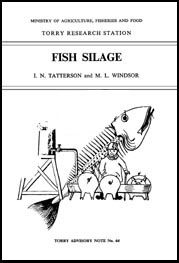Contents Index

Accompanying Notes
Table of Contents
I. N. TATTERSON and M. L. WINDSOR
MINISTRY OF AGRICULTURE, FISHERIES AND FOOD
TORRY RESEARCH STATION
TORRY ADVISORY NOTE No. 64
Crown copyright material is reproduced with the permission of the Controller of Her Majesty's Stationery Office.
This electronic document has been scanned using optical character recognition (OCR) software and careful manual recorrection. Even if the quality of digitalisation is high, the FAO declines all responsibility for any discrepancies that may exist between the present document and its original printed version.
Explains what fish silage is. Briefly describes its manufacture mainly from white fish offal, but also with some reference to production from fatty fish. Gives some information on storage and uses, and considers the advantages and disadvantages of making silage compared with fish meal. Read in conjunction with Note 49. It is important to emphasise that the requirements of current legislation on health and safety at work and environmental health need to be met.
(FAO in partnership with Support unit for International Fisheries and Aquatic Research, SIFAR, 2001).
Contents Index